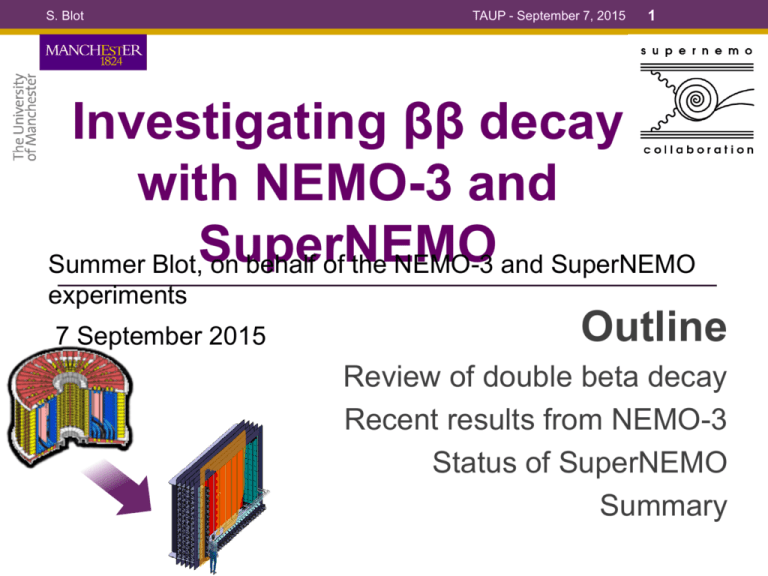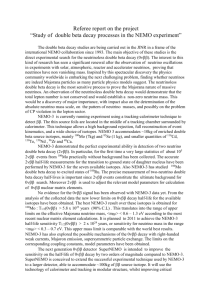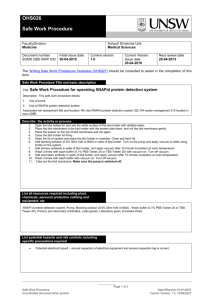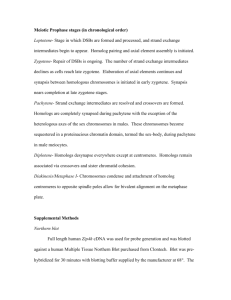SummerBlot_TAUP2015
advertisement

S. Blot TAUP - September 7, 2015 1 Investigating ββ decay with NEMO-3 and Summer Blot,SuperNEMO on behalf of the NEMO-3 and SuperNEMO experiments 7 September 2015 Outline Review of double beta decay Recent results from NEMO-3 Status of SuperNEMO Summary 2 S. Blot TAUP - September 7, 2015 2νββ decay 0νββ decay Occurs if β-decay is forbidden or highly suppressed (35 isotopes) nd order weak process in the 2 Standard Model (SM) (T½ ~101821 yrs) Detect 2 electrons with continuous ΣEΤΟΤ ( νe’s escape detection) Arbitrary units BSM process that violates ΔL conversation by 2 units Can be mediated by: Light Majorana ν, (V+A) current, SUSY Observed final state identical to 2νββ 2νββ 0νββ ΣEe < Qββ ΣEe = Qββ S. Blot TAUP - September 7, 2015 Why search for 0νββ decay? Observation of 0νββ decay would provide first evidence that lepton number is not conserved (LPV) Test Dirac vs Majorana nature of the neutrino If underlying mechanism is light Majorana neutrino exchange, can determine mass scale of neutrino (T ) 0n -1 1/2 = G0n (Qbb , Z) M 0n h 2 Theoretical input 2 3 S. Blot TAUP - September 7, 2015 4 The NEMO-3 experiment Operated from Feb 2003–Jan 2011 Modane Underground Laboratory (LSM) Passive detector design Source ≠ Detector Cylindrical geometry (R,φ,z) 7 different isotopes investigated Separate tracker-calorimeter systems Ability to reconstruct full kinematics of final state S. Blot TAUP - September 7, 2015 5 The NEMO-3 experiment y Central tower Source foils z z y x φ R Operated from Feb 2003–Jan Inner calo. 2011 wall Outer Modane Underground calo. Laboratory (LSM) wall Passive detector design x Source ≠ Detector Trackin Cylindrical geometry (R,φ,z) g 7 different isotopes volume investigated Separate tracker-calorimeter systems Ability to reconstruct full kinematics of final state S. Blot The NEMO-3 detector TAUP - September 7, 2015 6 ~10 kg of ββ-decay isotopes 100Mo,82Se,130Tl,116Cd,150Nd,96Zr and 48Ca Produced as thin foils 3060mg/cm2 Typically 2.5 in height, 63-65 mm Tracking chamber (both sides wide of foil) 6180 Geiger cells (50μm) operating in gas mixture of 95% He, 4% alcohol, 1% Ar and 0.1% H 2O Vertex resolution σ XY~3 mm,in Calorimeter (top, bottom, σZ~10mm and out) 1940 optical modules 3” and 5” PMTs coupled to polystyrene scintillator blocks σ ~14-17% (FWHM), σ ~250 ps E t S. Blot TAUP - September 7, 2015 7 The NEMO-3 experiment – ββ-decay sources Observation of 0νββ must be confirmed in multiple isotopes NEMO-3 (SuperNEMO) designed with this in mind S. Blot 8 TAUP - September 7, 2015 The NEMO-3 experiment – Detection principle Select events with two Right-handed Current 1 1 Theoretical Reconstructed Events electrons outgoing from the foil with common vertex Measure all relevant kinematics to reject backgrounds and investigate 0νββ topology if observed Mass mechanism 0.8 Theoretical Reconstructed 0.8 0.6 0.6 0.4 0.4 0.2 0.2 0 0 -1 -0.8 -0.6 -0.4 -0.2 0 0.2 0.4 0.6 0.8 1 -1 B Events Mass mechanism E1 t1 l1 cosθ l2 E2 t2 -0.8 -0.6 -0.4 -0.2 0 0.2 0.4 0.6 0.8 1 cosθ between electrons Right-handed Current 1 1 0.8 0.8 0.6 0.6 0.4 0.4 0.2 0.2 0 0 0 0.5 1 1.5 2 2.5 3 0 0.5 1 1.5 2 2.5 energy difference between electrons (MeV) 3 S. Blot TAUP - September 7, 2015 Backgrounds External backgrounds from neutrons capture, producing high energy γ-rays Reduced by tagging α-particles from 214Bi-214Po cascade Internal background decays External backgrounds γ Radon induced backgrounds Reduced with 4800m water equivalent overburden and extensive passive shielding (wood, iron, borated water) Internal backgrounds e.g. Single β-decay + Møller scattering + conversion electron + γ + Compton scattering 2νββ decay Irreducible – must measure rate with Use background topology to measure expected rates γ 9 S. Blot Background channels External background channels (top right) identified by distinct time sequence of scintillator hits in the event (ti << tj) TAUP - September 7, 2015 10 [arxiv:1506.05825] External e-γ Single e Single electron channel (bottom right) provides channel to measure isotopes which undergo single β- S. Blot 11 TAUP - September 7, 2015 Latest NEMO-3 Results – 100Mo Best 0νββ sensitivity in NEMO-3 Phys. Rev D 89, 111101 (2014). [arxiv:1506.05825] using 34.7 kgy 100Mo No significant excess of data over expected background in region of interest: ETOT = [2.8-3.2] MeV Limits derived on T (0νββ) for ½ various <mprocesses > < 0.33-0.62 eV ββ 0νββ Mechanism <T1/2 x1024y @90% CL Physics parameter Mass mechanism 1.0 mββ < 0.33-0.62 eV RH current <λ> 0.6 <λ> < (0.9-1.3)x10-6 RH current <η> 1.0 <η> < (1.6-2.4)x10-8 0 -5 S. Blot TAUP - September 7, 2015 12 Comparison to other isotopes Most stringent half-life limit on 0νββ with 100Mo from NEMO-3 (top) Translation into effective neutrino mass also shown (bottom) See [arxiv:1506.05825] for references to S. Blot TAUP - September 7, 2015 13 Other results from NEMO-3 Best results of 2νββ T½2ν(100Mo)= 7.16 ± 0.01stat ± 0.54syst Updated results coming soon… T½ measurements for all 7 isotopes investigated Best 0νββ decay limits for many as well See backup slides for details or J.Phys.Conf.Series 375 (2012) 042011 S. Blot TAUP - September 7, 2015 14 Moving towards SuperNEMO SuperNEMO shares the same detector design principles as NEMO-3 Modular in design first module (of 20 total) is the demonstrator 82Se and with 2.5y will reach Demonstrator will house 7kg of Feature NEMO-3 SuperNEMO sensitivity ofMo<mββ> ~ 0.2 –Se0.4 eV Isotope ( Ca, Nd) 100 82 Mass 7 kg 100 kg Radiopurity A(208Tl) < 20 μBq/kg A(208Tl) < 2 μBq/kg (activity) A(214Bi) < 300 μBq/kg A(214Bi) < 10 μBq/kg A(Rn) < 5 mBq/m3 A(Rn) < 0.15 mBq/m3 Efficiency 18% 30% σE (FWHM@3MeV) 8% 4% Sensitivity 0ν T1/2 > 1 x 1024 mββ < 0.3 – 0.8 eV 0ν 48 150 T1/2 > 1 x 1026 mββ < 0.04 – 0.1 eV *Values in table correspond to the full 20 modules of SuperNEMO Full SuperNEMO: mββ~ 0.04-0.1 eV S. Blot TAUP - September 7, 2015 15 The SuperNEMO detector 7kg of 82Se per module (150Nd purification studies ongoing, 48Ca also possible) Thin foils with better radiopurity 208Tl Factor of x10 decrease in contamination and x30 decrease in 214Bi Calorimeter: two main walls 5” and 8” PMTs coupled to scintillator block with optimized geometry σ ~ 7.8% (FWHM) for electrons E @1MeV B Tracking chamber (both sides of foil) Wire chamber operating in Geiger S. Blot TAUP - September 7, 2015 16 SuperNEMO demonstrator status – source foils ~25% of source foil produced for demonstrator (82Se) Radio-purity measurements underway using the dedicated BiPo detector Source foil mounting test The BiPo detector S. Blot TAUP - September 7, 2015 17 SuperNEMO demonstrator status – tracker Wiring robot for cell production First half of tracker complete First quarter (aka C0) commissioned, ready for shipment to LSM Populating a C-section First tracks in C0 98.4% of cells fully operational! (504 total) Radon tests for C1 underway, commissioning to follow Bottom seal plate S. Blot TAUP - September 7, 2015 18 SuperNEMO demonstrator status – calorimeter Production and testing of optical modules is well underway Energy resolution meeting design specifications Optical module production and testing S. Blot TAUP - September 7, 2015 19 SuperNEMO demonstrator status – radiopurity All materials screened for radiopurity with HPGe detectors and radon emanation chamber Radon concentration line to measure Rn in tracker gas (Target < 0.15 mBq/m3) Preliminary measurements of radon in C-sections are very promising!! Radon centration line Radon emanation chamber S. Blot TAUP - September 7, 2015 20 SuperNEMO demonstrator status – software Many tools already implemented and validated Event generation and simulation of detector components Event reconstruction and particle ID Improved tracking algorithms α –particle ID Advanced γ tracking algorithm S. Blot TAUP - September 7, 2015 21 SuperNEMO demonstrator integration Support frame installed at LSM C-section ready for transport to LSM SuperNEMO Demonstrator starting to take shape Optical module production underway Commissionin g by 2016 S. Blot TAUP - September 7, 2015 22 <mββ> = |m1|Ue1|2 +m2|Ue2|2eiα + m3|Ue3|2eiβ| Sensitivity of next generation 0νββ experiments Current best limit at mββ < 130 - 310 meV (90% CL) SNO+, SuperNEMO, CURORE< EXO+, GERDA, KAMLAND-Zen+ (2017– ) SNO+ ungraded, nEXO, SuperKamLAND-Zen Assumes 3 neutrino mixing model P. Guzowski et al., Submitted to PRD (2015). arXiv:1504.03600v1 [hep-ex] S. Blot TAUP - September 7, 2015 23 Summary The NEMO-3/SuperNEMO experiments offer a unique way to search for 0νββ decay and disentangle underlying mechanisms Analysis of full data set from NEMO-3 is ongoing Best results with 100Mo yield mββ < 0.33-0.62 eV 82Se, 116Cd 150Nd, 96Zr Coming soon: new results from Construction of SuperNEMO demonstrator is and 48Ca well underway Many of the most challenging design specifications have been achieved or are very close to being met Commissioning of demonstrator should begin next year (2016) Goal is to reach m ββ < 0.2-0.4 eV in just 2.5 years of running Thank you for your attention! S. Blot TAUP - September 7, 2015 BACKUP SLIDES 24 S. Blot TAUP - September 7, 2015 Dirac vs Majorana Schechter-Valle theorem Image from Neutrino Physics Kai Zuber, IoP Publishing 2004 25 S. Blot DESY seminar 2015 26 Experimental considerations for 0νββ Choice of isotope Large G0ν and M0ν for shorter T1/2 Large Q ββ for background rejection Large mass of isotope of interest Enrichment, purification, abundance GERDA Detector design Good energy resolution Radio-pure materials Active or passive Choice of location Experiments underground and protected by many layers of passive and active shielding to protect from cosmic muon NEMO-3 SuperNEMO SNO+ S. Blot DESY seminar 2015 27 NEMO-3 tracker Wire tracking chamber with 6180 cells operating in Geiger mode 95% He, 4% alcohol, 1% Ar, 0.1% H2O Vertex resolution: σXY ~ 3 mm, σZ ~ 10 mm + 25 G magnetic field for discrimination between e /e Ground wire Cathode ring Gaps for top/bottom calorimeter Single tracker cell anatomy Source foil Anode 4-2-3 layout on each side of source foil S. Blot DESY seminar 2015 Optical module anatomy NEMO-3 calorimeter 1940 optical modules 3” and 5” low-radioactivity PMTs coupled to large (10x10x10) scintillator blocks ~15% / √E @ 1 MeV Dedicated studies for PMT monitoring to ensure high quality modules used in analysis 28 PMT base electronics Magnetic shielding Optical fibre Light-tight sleeve Interface light guide PMT Light guide External wall of sector Iron ring Scintillator block Particle entrance 0 50 100 mm Aluminized Mylar coating PMT stability monitoring S. Blot DESY seminar 2015 29 NEMO-3 calibrations Monthly absolute calibration runs with 207Bi sources + runs with 90Sr source for calibrating up to 3 MeV Check PMT stability with daily laser survey (82% of PMTs stable for entire lifetime of experiment) 207Bi C.E. peaks Laser survey validation 90Sr (90Y) endpoint S. Blot TAUP - September 7, 2015 30 Measuring backgrounds: 214Bi-214Po cascade Electronics store Geiger hits information up to 700μs after event trigger 214Bi-214Po cascades with Tag one electron and one cluster of delayed Geiger hits (α) 1e1α event display 214Po half-life is 164.3μs arxiv:1506.05825 S. Blot TAUP - September 7, 2015 31 Measuring backgrounds: Crossing electrons + - High energy external γ-flux can produce e e pairs in foil Use passive shielding to reject most events (slide 9) NIM A 606: 449-465, 2009 Use calo timing information to tag and characterize external events Crossing electron S. Blot TAUP - September 7, 2015 32 Measuring backgrounds: electron + gammas Many internal background decay to excited states of their daughter isotopes Tag γ rays emitted 100in Mo 1e2γ & 1e3γ de-excitation to identify these backgrounds Channel selects one electron and N scintillator hits without tracks arxiv:1506.05825 S. Blot TAUP - September 7, 2015 33 Results from NEMO-3 Mass (g) 2νββ T1/2 (x1019 y) 0νββ T1/2 (90% CL) Reference 82Se 932 9.6 ± 0.1stat ± 1.0syst > 3.2 x 1023 PhysRevLett 95 (2005) 182302 150Nd 37.0 0.91+0.025-0.022stat ± 0.063syst > 1.8 x 1022 PhysRevC 80 (2009) 032501 Isotop e Nucl.Phys.A847 (2010) 168 9.4 2.35 ± 0.14stat ± 0.16syst > 9.2 x 21 82Se for full exposure! New results soon for 150Nd, 48Ca, 116Cd 10 and 96Zr 130 PhysRevLett 107 (2011) S. Blot 100Mo TAUP - September 7, 2015 34 0νββ result Event break-down Dominant systematic is absolute normalization on 0νββ efficiency Contribution External background N2e events ETOT = [2.8-3.2] MeV Systemati cs < 0.2 0νββ efficiency 214Bi from radon 5.2 ± 0.5 214Bi 214Bi internal 1.0 ± 0.1 internal 208Tl internal 3.3 ± 0.3 208Tl 2νββ 8.45 ± 0.05 Total Expected 18.0 ± 0.6 internal % Estimation method 7.0 Activity of 207Bi calibration sources HPGe v NEMO 10. Variation of activity 0 between bkg. channels 10. Activity of 232U 0 calibration sources HPGe v NEMO






